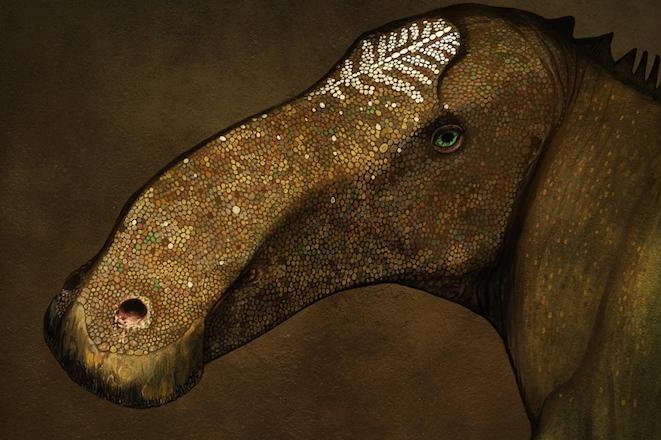An artistic rendering of Probrachylophosaurus bergei, Superduck. Photo by John Conway/Montana State University
BOZEMAN, Mont., Nov. 12 (UPI) -- Researchers at Montana State University have identified a new duck-billed dinosaur species dubbed "Superduck." Its scientific name is Probrachylophosaurus bergei.
The large herbivore lived 79 million years ago in the western half of North America. Scientists say Superduck is a transitional species, filling in a gap between 81-million-year-old Acristavus and 77.5-million-year-old Brachylophosaurus.
Superduck's modest crest fits in between its earlier relatives with no crest and its descendants with larger crests.
"We knew what lived earlier and later," Elizabeth Freedman Fowler, curator of paleontology at the Great Plains Dinosaur Museum, told the Billings Gazette. "Now we've found a new species that is filling in that gap."
"It's a pretty important dinosaur considering the fact that it shows an evolutionary transition," added Jack Horner, professor of paleontology at Montana State. "You don't see that too often. Most of the snapshots we get of animals are so separated in time that we only see different species."
In 2007, Freedman Fowler and Horner began excavating fossil-rich mudstone at dig site near the town of Rudyard in north central Montana. There they ultimately discovered the adult Superduck. A juvenile specimen was recovered nearby, allowing them to better understand how the transitional species developed.
Their ability to study anatomical changes from juvenile to adult and from species to species is rather unique, the researchers say.
"The Late Cretaceous of western North America is the only place in the world where we can do these kinds of intense paleobiological studies on dinosaurs," Freedman Fowler said in a press release. "Nowhere else combines the precise dating of rocks coupled with an exceptional fossil record that has been so extensively collected."
The dino's discovery is detailed in the journal PLOS ONE.















